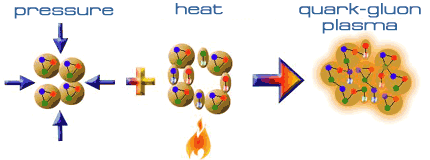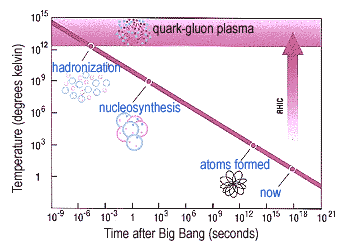While many RHIC collisions will produce interesting results,
a rare few might create something even more special: a new form of
matter.
Actually, it's not new to the universe, just to human eyes. It's
thought to have existed ten millionths of a second after the Big Bang at
the dawn of the universe. It may also exist in the cores of very dense
stars called neutron stars.
This form of matter is called quark-gluon plasma or QGP. Like its
name suggests, QGP is a "soup", or plasma, of quarks and
gluons. (see physics primer)
Physicists believe that RHIC collisions will compress and heat the
gold nuclei so much that their individual protons and neutrons will
overlap, creating an enormously energetic area where, for a brief time,
a relatively large number of free quarks and gluons can exist. This is
the quark-gluon plasma.
Below, you can see this phase transition (see physics primer) up
close. The red, green and blue circles are quarks, connected by black
lines representing gluons. At the beginning, trios of quarks and gluons
are packaged in protons and neutrons, which are held together in the
nucleus of an atom. As the pressure and temperature rise, new particles
called pions (made of a quark and an anti-quark, shown in pastels)
arise.

Finally, the conditions are just right for the phase transition to
happen, and quark-gluon plasma is produced. Note that in the plasma, the
quarks, gluons and anti-quarks are liberated from their usual bonds, and
bond with one another freely.
If a RHIC collision produces a QGP, it will quickly cool, expand and
coalesce into hadrons (see physics primer). Physicists will be able to
determine if a QGP was produced not by observing it directly -- its
lifetime is too brief -- but by looking at the particles that shower out
from the collision.
A collision that produces QGP will send out different kinds and
ratios of particles than a collision that doesn't produce QGP. QGP is
predicted by the standard model of particle physics (Quantum
Chromodynamics), so theoretical physicists can calculate what signals it
should produce.
The next figure shows a timeline of how the universe is thought to
have evolved as it cooled following the Big Bang. The top, purple band
is the realm where QGP can exist, at very high temperatures above
1,000,000,000,000 degrees. Starting from the bottom left, you can track
the evolution of the universe as it ages from 0.000000001 seconds to
today.

As the universe aged and cooled, the plasma coalesced into protons
and neutrons (hadronization), then nuclei (nucleosynthesis) and then
atoms. Finally, the atoms came together into molecules, which allowed
life to arise.
As you can see by the purple arrow, RHIC will recreate (on a small
scale) the temperatures that existed at the dawn of the universe. By
creating QGP over and over again under laboratory conditions, RHIC's
physicists expect to gain a new understanding of the relationship
between the most fundamental constituents of matter and the complex
array of particles and nuclei that make up the world around us.
On
to Spin physics >

